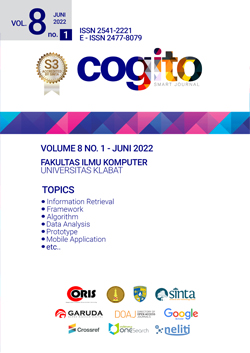AUDIT STRATEGI TATA KELOLA IT PADA STMIK BINA NUSANTARA JAYA LUBUKLINGGAU MENGGUNAKAN FRAMEWORK COBIT 5
DOI:
https://doi.org/10.31154/cogito.v8i1.372.244-258Abstract
In the implementation of academic and non-academic activities STMIK Bina Nusantara Jaya Lubuklinggau has integrated and implemented the use of information technology through SIAKAD ( Academic System) . To be able to carry out the implementation of information technology according to service quality orders and a framework which later can help an organization to be able to improve or improve technology governance in accordance with IT governance standards. Information technology governance, in its role, has many tools to carry out assessments and measurement indicators to help universities. In this study, the author uses cobit 5 famework as an IT governance standard. In the COBIT 5 process, the author only uses the APO 11 and MEA 01 processes. The APO11 (Quality of Service) process has 6 attributes that are used and MEA (Monitor, Evaluate, assess conformance and Conformance) has 5 attributes that are used. There is a gap value between attributes, current conditions and what is expected. The results of the gap analysis obtained in the APO11 and MEA processes still have numbers 1 and 0. The results of the gap number 1 indicate that the current condition is still not good with the expected conditionsKeyword- Audit,Governance, Cobit 5, APO,MEAReferences
A. Prof. Dr. Jogiyanto HM, MBA, Sistem Teknologi Informasi. Yogyakarta, 2008.
Y. Fadhillah S and J. Waterkamp, “Analisa Dan Perencanaan Strategis Sistem Dan Teknologi Informasi Menggunakan Balance Scorecard Pada Institut Bisnis Dan Informatika Kwik Kian Gie,” J. Sist. Inf., vol. 12, no. 1, p. 17, 2016, doi: 10.21609/jsi.v12i1.457.
M. M. Rio Septian Hardinata, Wirda Fitriani, Cahyo Pramono and A. K. Husni Muharam Ritonga, Leni Marlina, Suheri, “Audit Tata Kelola Teknologi Informasi menggunakan Cobit 5 (Studi Kasus : Universitas Pembangunan Panca Budi Medan),” J. Tek. Dan Inform., vol. 6, no. 01, pp. 42–45, 2019.
D. Y. Sari, W. Cholil, and L. Atika, “Optimalisasi Tata Kelola Ti Pada Kpu Kota Palembang Dengan Menggunakan Framework Cobit5,” … Teknol. Inf. dan …, pp. 244–249, 2018.
M. Muthmainnah, S. Safwandi, M. Jannah, and ..., “Evaluasi Tata Kelola Teknologi Informasi Menggunakan Framework Cobit 5 Proses Dss03 Dan Mea01 Di Universitas X,” J. Sist. …, vol. 6, pp. 1–12, 2021, [Online]. Available: https://ojs.unimal.ac.id/sisfo/article/view/4848.
Noorhasanah, W. W. Winarno, and D. Adhipta, “Evaluasi Tata Kelola Teknologi Informasi Berbasis Framework COBIT 5,” Eval. TATA KELOLA Teknol. Inf. Berbas. Framew. COBIT 5 Semin. Nas. Teknol. Inf. dan Multimed. 2015, pp. 6–8, 2015.
Hanif A, Giatman M, Hadi A, “Evaluasi Tata Kelola Teknologi Informasi Di Dinas Komunikasi Dan Informatika Menggunakan Framework COBIT 5,” Sains J.Teknologi, vol. 9 no. 1 Tahun 2020.
ISACA, COBIT ® Process Assessment Model (PAM): Using COBIT ® 5. 2013.
ISACA, Enabling Processes skills and knowledge through the globally respected Certified Information Systems Auditor ® (CISA ® ). 2012.
L. Fahreni, E. S. Negara, and Y. N. Kunang, “Tata Kelola Terhadap Layanan IT Di Kejaksaan Tinggi Kep. Babel Berdasarkan Perspektif Internal Pada Cobit 5,” J. Inform. Glob., vol. 11, no. 2, pp. 30–35, 2020, [Online]. Available: http://ejournal.uigm.ac.id/index.php/IG/article/view/1219.
Saleh M. et al, “Penerapan Framework COBIT 2019 pada Audit Teknologi Informasi di Politeknik Sambas,” JEPIN, vol. 7 no. 2 Tahun 2021.
M. P. Utami, A. P. Widodo, K. Adi, “Evaluasi Kinerja Tata Kelola Teknologi Informasi pada Sistem Aplikasi Elektronik Program Keluarga Harapan dengan COBIT 5,” Jurnal Komunika, vol. 10 no. 1 Tahun 2021, http://doi.org/10.31504/komunika.v9i1.3529.
P. Herlambang, I. Nuryasin, W. Suharso, “Audit Sistem Informasi Menggunakan Framework COBIT 4.1 Domain Acquire and Implementasi (AI) (Studi Kasus : Dinas Komunikasi dan Informatika Kota Malang),” Jurnal teknologi dan Informatika, vol. 4 no. 2 Tahun 2018.
P. A. Moonda , B. Norita, “Audit Tata Kelola Teknologi Informasi Menggunakan Framework Cobit 5 (Studi Kasus : PT. Jamkrida Provinsi Jawa Tengah),” Jurnal Masyarakat Informatika, vol. 11 no. 1 Tahun 2019.
B. Nadhiro, O. Purwaningrum, S. Mukaromah, “Studi Literatur : Framework Cobit 5 Dalam Tata Kelola Teknologi Informasi,” Universitas Pembangunan Nasional, Vol. XVI Nomor 2 – Juni 2021.
R. Patawala, A. D.Manuputty, “Audit Sistem Informasi Pada Dinas Perpustakaan Dan Kearsipan Kota Salatiga Menggunakan Framework Cobit 4.1 Domain Monitor And Evaluate,” Sebatik Vol. 25 No. 1 Juni 2021, ISSN: 1410-3737(p) 2621-069X(e), Open access article licensed under CC-BY, DOI:10.46984/sebatik.v25i1.1322.
M. D. Irawan, A. Seraya, N. Amalia, and R. R. Arifianda, “Penerapan Cobit 5 dalam Evaluasi Tata Kelola Teknologi Informasi (Studi Kasus: Dinas Perindustrian dan Perdagangan Provinsi Sumatera Utara),” J. Teknol. Sist. Inf. dan Apl., vol. 3, no. 4, p. 185, 2020, doi: 10.32493/jtsi.v3i4.6154.
T. M. Insani, Samsudin, A. Ikhwan, “Implementasi Framework Cobit 2019 Terhadap Tata Kelola Teknologi Informasi Pada Balai Penelitian Sungei Putih,” Jurnal Teknik Informatika Kaputama (JTIK), Vol.6, No. 1, Januari 2022
Antonius C. Rudianto, P. F. Tanaem, “Evaluasi Kinerja Tata Kelola Teknologi Informasi Menggunakan Framework Cobit 5 (Studi Kasus: Pt. Adicipta Inovasi Teknologi),” Jurnal Bina Komputer, JBK, Vol. 2, No. 2, Juli 2020: 39-54.
Downloads
Published
How to Cite
Issue
Section
License
Authors who publish with this journal agree to the following terms:- Authors retain copyright and grant the journal right of first publication with the work simultaneously licensed under a Creative Commons Attribution License that allows others to share the work with an acknowledgment of the work's authorship and initial publication in this journal.
- Authors are able to enter into separate, additional contractual arrangements for the non-exclusive distribution of the journal's published version of the work (e.g., post it to an institutional repository or publish it in a book), with an acknowledgment of its initial publication in this journal.
- Authors are permitted and encouraged to post their work online (e.g., in institutional repositories or on their website) prior to and during the submission process, as it can lead to productive exchanges, as well as earlier and greater citation of published work (See The Effect of Open Access).





























